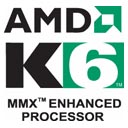AMD K6 (Little Foot) processors
Introduction: April 1997
The K6 microprocessor was launched by AMD in 1997. The significance of this particular microprocessor is that it was designed to fit into existing Pentium desktop designs. What is more it was marketed as being a product which could perform as well as its Intel Pentium equivalent but at a significantly lower price. The K6 had a considerable impact on the PC market and presented Intel with serious competition.
The AMD K6 is a Pentium-class microprocessor, manufactured by AMD, which superseded the K5. It was co-developed by Vinod Dahm, inventor of the Pentium processor. The AMD K6 is based on the Nx686 microprocessor that NexGen was designing when it was acquired by AMD. NexGen had been intending to market this chip in its own socket, but AMD changed the design to fit the standard Socket 7, added MMX support, and renamed it the K6. Despite the name implying a design evolving from the K5, it is in fact a totally different design that was created by the NexGen team and adapted after the AMD purchase.
The K6 was originally launched running at speeds of 166 and 200MHz in April 1997. It was followed by a 233MHz version later in the summer of 1997. The release of the 266MHz version of this chip was not until spring 1998 when AMD were able to move to the 0.25 micrometre manufacturing process. The final iteration of the K6 design was released in May 1998 running at 300MHz and continued with the K6-2 and the K6-III.
Initially, the AMD K6 processors used Pentium II Rating (PR2) to designate their speed. The PR2 rating was dropped because the rated frequency of the processor was the same as the real frequency.
Many viewed the K6 and the acquisition of NexGen as the moment that AMD was put back into the Intel compatible processor market. The actual K6 had been designing was anemic compared to NexGen's design. With the buyout of NexGen, AMD was able to come back into the game with a processor that could perform competitively with Intel's Pentium II.
Source: Wikipedia, the free encyclopedia.


